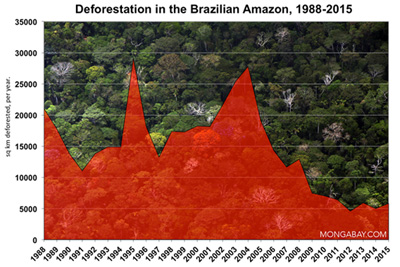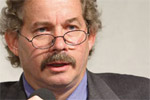Mongabay.com is partnering with the Skoll Foundation ahead of the Skoll World Forum on Social Entrepreneurship to bring a series of perspectives that aim to answer the question: how do we feed the world and still address the drivers of deforestation?
|
HOW DO WE FEED THE WORLD AND STILL ADDRESS THE DRIVERS OF DEFORESTATION? Soy, cattle, rice, palm oil, and logging are the principal drivers of deforestation. As global population increases from 7 billion to 9 billion by 2040, and as more and more people around the world rise out of poverty into the middle class, the demand for these commodities and practices will continue to rise with them. To address these issues, and in advance of the World Forests Summit hosted by the Economist in March, the Skoll World Forum on Social Entrepreneurship partnered with the Stanford Institute for the Environment and Mongabay News to surface the latest insights and innovations at the intersection of deforestation and sustainability. This debate will also set the stage for a larger discussion on deforestation at this year’s Skoll World Forum in Oxford, UK. |
The history of the Brazilian Amazon has long been marked by deforestation and degradation. Until recently the situation has been considered out of control. Then, in 2004, the Brazilian government launched an ambitious program to combat deforestation. Public pressure—both national and international—was one of the reasons that motivated the government to act. Another reason was that in 2004, deforestation contributed to more than 55 percent of Brazil’s total greenhouse gas emissions, making Brazil the fourth-largest greenhouse gas emitter in the world.

|
Initially, the government program led to the creation of protected areas and indigenous lands, now constituting about 40 percent of the Brazil’s Amazon, combined with significant advances in command and control efforts. Most notably, there was a sharp increase of enforcement to stop illegal activities. In addition, Brazil’s National Institute for Space Research and Imazon launched monitoring systems, using near real-time satellite images to track deforestation. And finally, Brazil decided to suspend credit to all landowners if they do not stop illegal deforestation. This set of measures made it possible for Brazil to reduce annual deforestation from 19,600 square kilometers (the average for 1996-2005) to about 6,300 square kilometers (average for 2009 to 2012). This represents a more than 80 percent reduction of deforestation, with avoided emissions of CO2 equivalent to approximately 2.2 gigatons—the greatest reduction achieved by humankind. To put this into perspective, 2.2 gigatons is comparable to the emissions resulting from fuel burning in 2008 from India and China combined, according to the IEA.
 Beto Veríssimo Co-founder and CEO, Imazon Beto Veríssimo is a co-founder of Imazon, a think-and-do thank based in the Brazilian Amazon. He holds a master degree in Ecology from Penn State University (USA) and Agriculture Engineer degree from the Amazon Federal Rural University. In 2010 Veríssimo received the Skoll Foundation Award for Social Entrepreneurship. He is also Avina Fellow and Ashoka Senior Fellow. |
How do we maintain these tremendous gains and move towards ending deforestation by 2020? The next wave of this effort is to have local initiatives to combat deforestation while transforming the land use from extensive to intensive. For example, agricultural expansion is an example of an extensive driver, while mining and mineral processing is an example of an intensive driver. One promising initiative is the Green Municipalities Program, launched in 2011 by State of Pará in the eastern Brazilian Amazon. Pará, with a huge territory of more than 1.25 million square kilometers (three times the size of California) already has lost 21 percent of its forests.
The key to the Green Municipalities Program’s approach is to have dialogue with all stakeholders, especially ranchers and loggers, clear goals and indicators, and a broad political coalition. The long-term goal is that of net zero deforestation in Pará by 2020, with milestones along the way. For example, deforestation in Pará should be below 1,200 square kilometers by 2016. This means that not only by 2020 do we expect zero illegal deforestation, but that all legal deforestation from that point on is to be compensated for with reforestation. So far the results are promising: deforestation in Pará reached 1,700 square kilometers in 2012, the lowest in history. Moreover, rural property registration (defining property boundaries) has skyrocketed from less than 600 properties in 2009 to more than 64,000 in 2012. Now almost 40 percent of Para’s rural properties can be easily monitored using satellite images, which can also track all rural production.
Of course, there are still many challenges ahead. On the economic side, it is critical to attract investments to move forward with the intensification of land use. For example, the Brazilian pilot initiative on low-carbon agriculture needs to be scaled up, along with forest management and reforestation. Moreover, potential payments for environmental services such as REDD are very welcome. But on the other hand, hydroelectric projects underway can catalyze massive migration and land use speculation—reigniting strong drivers of deforestation. Ultimately, however, Brazil’s international commitment to reduce deforestation in the Amazon by at least 80 percent by 2020 is critical to keeping the country on the right track. We have made great progress thus far, but there is still more work to be done.
To discuss this commentary, please visit A PROMISING INITIATIVE TO ADDRESS DEFORESTATION IN BRAZIL AT THE LOCAL LEVEL
|
ALL POSTS IN THIS SERIES
6 lessons for stopping deforestation on the frontier (04/09/2013) In 1984, at the tail end of the Brazilian dictatorship, I took up residence in a frontier town called Paragominas in the eastern Amazon. I went to study rainforests and pasture restoration, but soon became captivated as well by the drama of the frontier itself. Forests were hotly contested among cattle ranchers, smallholder communities, land speculators and more than a hundred logging companies, sometimes with fatal results. If we are to meet rising global demand for food, conserve tropical forests, and mitigate climate change at the pace that is necessary, we must become much better at taming aggressive, lawless tropical forest frontiers where people are making a lot of money cutting forests down. Can we meet rising food demand and save forests? (04/03/2013) A few weeks ago the Skoll World Forum hosted an online debate on how increased global consumption can be balanced with sustainability. The debate asks how a rapidly growing world that is ever consuming can hope to feed everyone, and at the same time address the deforestation that is emitting massive amounts of carbon into the atmosphere and destroying the world’s greatest tropical forests. Many contributors made very strong points—even contradicting one another in their approaches and ideas. Strong ‘no deforestation’ commitments save forests and feed people (03/12/2013) As a global community, we have so far failed to answer this most pressing question; we have yet to build our cloud. Deforestation rates are down in some places, but overall, our forests continue to disappear much as they have for the past 50 years, driven principally by increasing global demand for food. Can we feed the world and save our forests? Yes, we can, and the solution lies in the global supply chain and the message some companies are now sending their suppliers: ‘If you cut down trees, I won’t buy your product.’ This has the power to silence bulldozers. It’s already doing so and now it’s time to go to scale. The need to jump-start REDD to save forests (03/08/2013) At least US$7.3 billion has been pledged for REDD+ over the period from 2008 to 2015, with $4.3 billion pledged for REDD+ readiness during the fast-start period alone (2010-2012). In addition to these funds, private investors, private foundations, and others have been channeling financial support to developing countries for REDD+ and related programs for several years now. A promising initiative to address deforestation in Brazil at the local level (03/05/2013) The history of the Brazilian Amazon has long been marked by deforestation and degradation. Until recently the situation has been considered out of control. Then, in 2004, the Brazilian government launched an ambitious program to combat deforestation. Public pressure—both national and international—was one of the reasons that motivated the government to act. Another reason was that in 2004, deforestation contributed to more than 55 percent of Brazil’s total greenhouse gas emissions, making Brazil the fourth-largest greenhouse gas emitter in the world. Saving forests by putting a price on them (03/04/2013) During the 2013 SuperBowl, the championship game of the US National Football League, a truck company aired an advertisement that likened farmers to God’s favorite assistant. It suggested that when God needs something tough, or gentle, done, he calls a farmer. The narration, taken from a speech given to the Future Farmers of America in 1978 by Paul Harvey, a radio host, plays directly to the near mythical stature of farmers and ranchers in American culture and their deep connection to nature. Saving forests by stemming agricultural sprawl (03/01/2013) I’m fortunate to travel the world helping conserve habitats for some of the world’s most iconic species. When I visit places like the Amazon and Sumatra, I’m still awestruck by their diversity and pristine beauty. I’m also reminded how threatened they are. Our growing demand for food and fiber is fueling deforestation in resource-rich regions of the world. As environmentalists, if we don’t change where and how we produce food and fiber, we can turn off the lights and go home. There won’t be any biodiversity left to protect. Can saving forests help feed the world? (02/28/2013) As world population climbs from 7 to a projected 9 billion people and emerging and developing economies demand ever more of the food and fiber that drive deforestation, many environmentalists ask with increasing urgency whether and how tropical forests can survive. But the question may actually be whether and how the world’s increasing, and increasingly rich, population can be fed unless tropical forests survive. The challenge of putting Brazil’s forests in good hands (02/28/2013) People often associate Brazil with its forests. It’s no wonder given that nearly 60% of the country’s territory is covered by forest and it holds about one-third of the world’s remaining tropical rainforests. You might assume that a country like this would care about educating people to sustainably manage this precious heritage. Well, you’d be wrong! The corporate conservation revolution (02/27/2013) There’s a new kind of environmental hero emerging. They don’t live in Washington, D.C., and they’re known more for their interest in increasing earnings than in reducing greenhouse gases. They are found in an unlikely place: The Corporate Boardroom, and they’re making a big difference in saving the worlds forests and our climate. In recent years, a group of visionary corporate leaders have been quietly teaming up with a growing number of environmental groups to take a hard look at what’s left of our planet’s natural resources. Together, they agree: we are past the point where our land and oceans can meet the food, energy and commodity demands of our planet’s seven billion inhabitants. |
Editor’s note: The opinions expressed in this op-ed do not necessarily reflect the views of Mongabay.com or its staff. Mongabay founder, president, and editor Rhett A. Butler served as an advisor to the Skoll Foundation from 2010-2012.
Related articles









